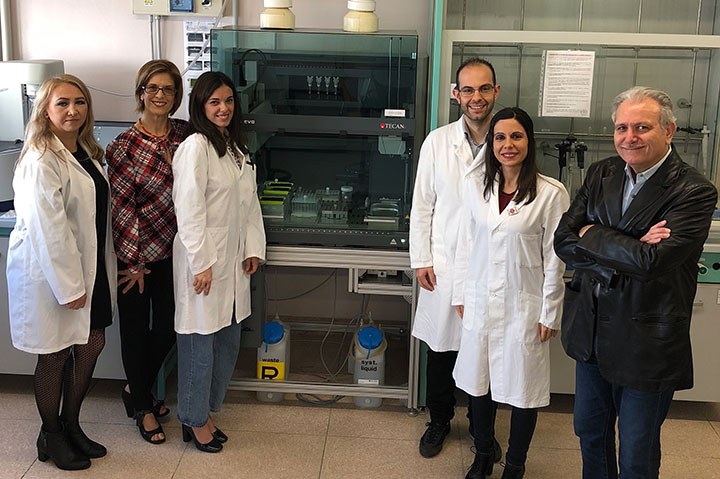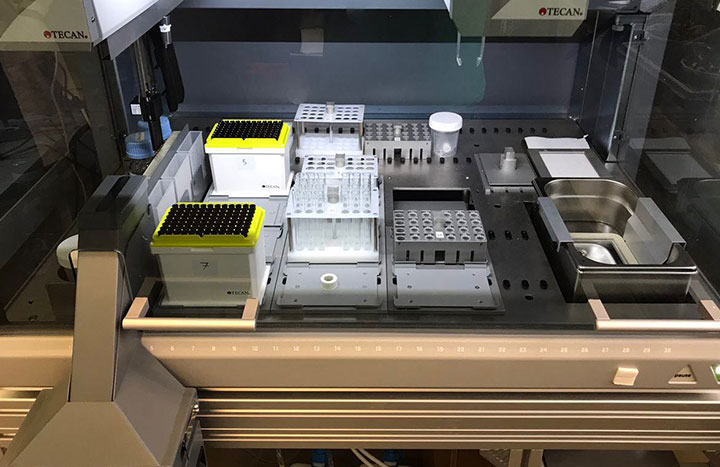Personalized medicine is on the horizon, and cell membrane lipidomics may hold the key. Italian biotechnology company Lipinutragen is studying the relationship between the membrane status and dietary and health conditions. A crucial part of the process is the isolation of mature red blood cells, which can be performed more precisely and reproducibly using laboratory automation than by manual processing.
Bologna-based Lipinutragen, a spin-out of the Italian National Research Council (CNR), was founded in 2005 by Drs Chryssostomos Chatgilialoglu and Carla Ferreri, who drew on their expertise in synthetic and analytical chemistry to establish a lipidomics laboratory, focusing on the isolation of mature red blood cells to allow analysis of the membrane fatty acid profile. Carla, now Lipinutragen’s R&D Director and a Senior Researcher at CNR, explained: “The lipid profile of the mature red blood cell membrane is a comprehensive biomarker of a person’s state of health, quality of nutrition and lifestyle. This has benefits in both clinical applications – enabling the development of personalized treatment strategies – and specialist pharmacies, which can offer advice about dietary changes and supplements to address a lipid imbalance.”
Carla continued: “Typically, the first sign of a lipid imbalance is stress. Biochemical analysis may not give any indication of a pathology, but the person’s mood may change, or they might not sleep well and still feel tired when they wake up in the morning. These are all signs of a general imbalance, including the cell membrane lipid profile. The membrane contains two types of fats; those that can be produced by the body’s enzyme system, and those such as omega-3 and -6 fatty acids, which must be consumed as part of a balanced diet. The main cause of a nutritional imbalance is ignorance. People know that a lack of fruit in the diet can lead to a vitamin deficiency, but are simply not aware of the need to consume omega-3 and -6 fatty acids, which can lead to the development of essential fatty acid deficiency syndrome.”

The Lipinutragen team (left to right): Andreea Popa, Carla Ferreri, Anna Vita Larocca, Simone Deplano, Valentina Sunda and Chryssostomos Chatgilialoglu
“Sample preparation for lipidomic analysis is a laborious, time-consuming, multi-step process that is difficult to perform precisely by hand, and so we automated the workflow on a Freedom EVO® platform. Blood samples are collected in tubes containing EDTA – the only anticoagulant able to sequester calcium – and delivered to the laboratory within 24 hours. After centrifuging, plasma, platelets and lymphocytes are removed leaving the red blood cell layer. Red blood cells have a four-month life span, and the mature cells that we require are smaller in diameter and heavier than the others. We measure the diameter of the red blood cells using a SCEPTER™ 2.0 handheld cell counter (EMD Millipore), selecting those that are six microns across. These cells are removed and placed in water to rupture the membrane, and then centrifuged to produce a pellet. The phospholipids are extracted from the pellet using chloroform:methanol (2:1, v/v) and derivatized to form fatty acid methyl esters for analysis by gas chromatography. All stages except centrifugation, evaporation and GC analysis have been automated, which has made a big difference to our laboratory.”
"The result was a liquid handling system that is far more consistent and precise than manual pipetting, which is exactly what we need for lipidomic analysis."
“We chose the Freedom EVO because we needed a platform that could offer both precise tip movements and near perfect handling of a variety of solvents, including water, chloroform, methanol and hexane. The system also needed to be able to accurately remove the mature red blood cell layer, and so we worked with the Tecan Integration Group to customize the platform to mimic our manual pipetting procedures, setting up and refining unique software to control all the automated movements. The result was a liquid handling system that is far more consistent and precise than manual pipetting, which is exactly what we need for lipidomic analysis.”

Automation of the process on the Freedom EVO has enhanced precision
“Precision is essential from the outset, starting with the isolation of the mature red blood cells. Removal of the various layers above these cells is a crucial step and must be performed identically each time, which was extremely difficult to do manually. Reproducible liquid dispensing and aspiration was also challenging; with automation, we can precisely dispense the required volume of solvent or water, or aspirate the extraction solvent, which is important for quantitation. To ensure total confidence in our results, we run a monthly calibration procedure to verify the automated extraction and derivatization of a lecithin standard of known concentration, quantifying the results by GC analysis.”
“Determining the membrane lipid profile is the key to distinguishing between a pathological problem and essential fatty acid deficiency syndrome, and we are raising awareness of this concept across the medical field through training courses registered with the Italian Health Ministry. These courses are attended by doctors, pharmacists and biologists working in the fields of nutrition and metabolic problems, allowing them to extend their knowledge of the subject for accreditation and continuing professional development purposes. I believe that our lipidomic analysis protocol will become commonplace in the future, with people having an annual assessment. To keep pace with this demand, manual processes will need to be replaced with high throughput, automated systems, and so the next step is to gain high level accreditation from an international body for the protocol we have established. This will open the door to potential new projects at Lipinutragen and attract interest from other laboratories engaged in this type of work. Our aim is to make this platform available to other laboratories around the world, helping to standardize lipidomic analysis,” Carla concluded.
To find out more about Tecan’s Freedom EVO platform, visit www.tecan.com/freedomevo
To learn more about Lipinutragen, go to www.lipinutragen.it/en
Keywords:









